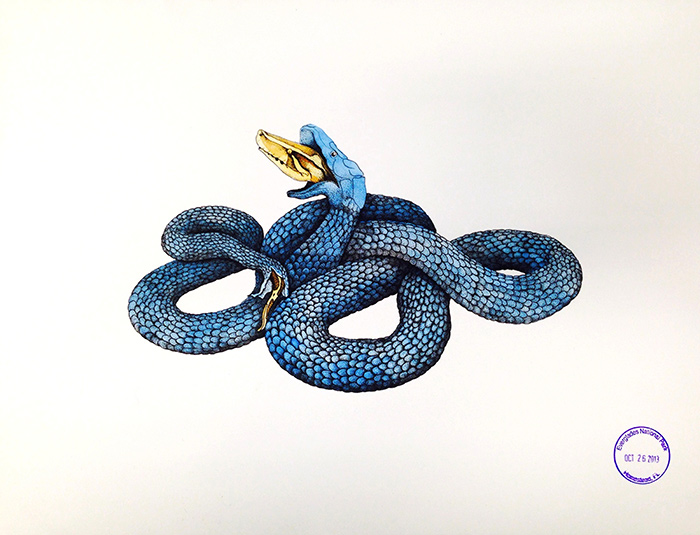http://www.resonantcity.net/rc/wp-content/uploads/2014/06/rc-header_6jpg-01.jpg
Bryan McGovern Wilson is a multi-disciplinary artist, whose interlocking long-term projects engage with questions of time, transformation, and the human/nonhuman relationship.
Resonant City: Thanks for talking with us today. Your projects the Great American Python, Cumbrian Alchemy, and Atomic Priesthood share a lot of overlapping themes. You were trained as a glassblower, right? How does glass serve as an entry point into your current practices?
Bryan McGovern WIlson: Glass is this magical material that we’re constantly surrounded by and is always relevant to my practice. My introduction to glass came to me as a teenager when I was living in Montana. I had this random introduction to this very particular, slightly esoteric practice of glassblowing from a nearby studio and this chance encounter set my current trajectory. This was the first moment of correspondence to my future practices happening right then. This idea that things repeat themselves, and things you come across in seemingly random ways, have a way of cycling back again. I went on to study glass at RISD and continue to work with it.
After I graduated from RISD, I got to a point where I just didn’t know what to do with glass as a sculptural material. I felt like I had spent all these years learning how to gain fluency with the material, but I simply did not know what I could say with it artistically. I had the presence of mind at the time to know that the frustration I was experiencing was a problem with me and not one with glass, so I really wanted to take that to task. What is it about this material that I feel compelled towards, but is absent in the things that I don’t identify with, which aren’t serving me well? What are the responsibilities one has towards craft, if any? Why use glass, really? Why use this when you could do it another way? I didn’t have good resolution to that but these projects emerged from these feelings.

Bryan McGovern Wilson, The Atomic Sigil, Ink on paper, 14 in x 12 in, 2012
RC: Tell us about the Atomic Priesthood project? What led you to the Trinity Test Site and Robert Oppenheimer?
BMW: Glass was the entry point. I wanted to find glass that occurred separate from any tradition that I understood, searching for ways in which the material existed absent a craft or art sensibility. So I was looking at things like fulgurites and glass sponges, glass that existed in the natural world. Then there’s Trinitite and there’s something about it that made me pause. Trinitite was the glass residue left over from the first nuclear detonation in 1945—the explosion did not leave a traditional crater, but left behind approximately a two hundred by six foot “lake” of greenish glass, dubbed Trinitite. It’s not aesthetically beautiful in any way. It’s technically radioactive, it’s nuclear waste, its fallout. And there was something about it that I was very curious about it and compelled towards understanding.
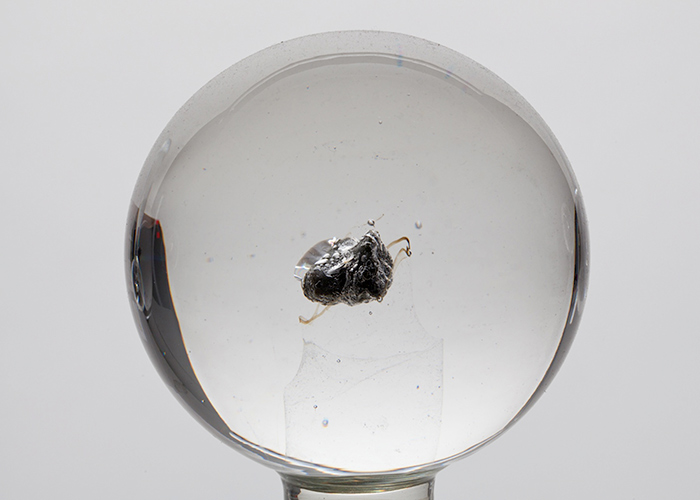
Bryan McGovern Wilson, Trinitite Reliquary, Glass, Trinitite, Detail, 2010-present
Rather than getting a bunch of the material and trying to make a sculpture or something out of it, I asked myself, what would it look like for me to do what I don’t particularly want to do? Which was to research the how and the why this emerged and what this thing actually is. And when I did that, things just started corresponding to one another and falling in to place. My mind was filled with the trajectory and principles of alchemy and hermetic philosophy and that was really a guiding force for me as a student. Those principals and that way of being was very important to me and still hold power for me. Whenever I felt lost in the studio, these hermetic traditions allowed an expansive way of thinking about materials, the self, and forces that resist convenient explanation. I found my alchemist in Robert Oppenheimer, he really fulfilled the archetype of an alchemist for me, a figure who had one foot in the practical, one in the ephemeral. After reading a fantastic biography of Oppenheimer, American Prometheus, that notion became crystallized. The book opened up conversations about the birth of the nuclear age, the development of the atom bomb, and the legacy of nuclear technology. All under the intimate lens of Oppenheimer as a deeply conflicted man at the center of many of these seismic scientific and cultural changes.
In October of 2009, I traveled from my home in Montana to The Trinity Nuclear Test Site in New Mexico, in search of Trinitite, dressed as Dr. J. Robert Oppenheimer the entire journey. The performance became a simultaneous research exercise, invocation, and pilgrimage.
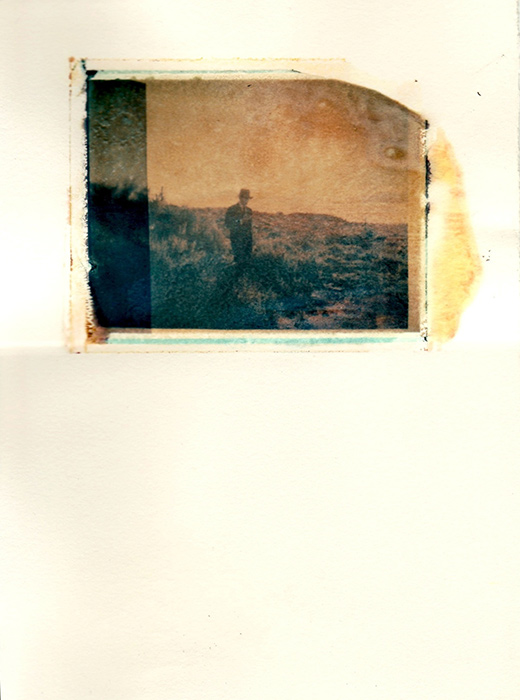
Bryan McGovern Wilson, The Trinity Pilgrimage (Emergence), Polaroid transfer on watercolor, Trinitite, 9 in x 7in, 2011
RC: How did you end up collaborating on the Cumbrian Alchemy project.
BMW: In 2009, I had just started working for the artist Mark Dion. One of the first things I was supposed to do was bring a large load of alchemic glass from the RISD glass department to Mildred’s Lane for an artist, Robert Williams. They were going to start building the Alchemist’s Shack, which is this allegoric building in reference to an Old World alchemist coming over to the United States, hiding out in the Pennsylvania countryside, but not being so good at hiding. The project tips its hat to how deeply spiritualism and the occult are intertwined within early formations of American identity. In the process of working on the Alchemist’s Shack, I got to know Robert Williams and there was this instant shared sensibility. This is where a lot of the esoteric stuff comes in, you form instant connections with people, that you really feel drawn to, a shared way of understanding the world. Through our conversations, the possibility of starting a project in Northern England emerged. He invited me to visit the University of Cumbria and, three years later, we completed the project Cumbrian Alchemy.
I was invited to come there and come up with a project in response to what was referred to as “The Energy Coast” in the Cumbrian region, which includes a variety of energy sources and their attendant facilities. My time in England was very open ended I was struck by the wealth of history embedded within the landscape. It was this amazing experience and opportunity, but a bit overwhelming.
The Cumbrian region of England has an interesting history. For starters, Sellafield is the company that invented the process of nuclear waste vitrification, which is now industry standard for all high radiation nuclear waste. You trap high radiation waste in a glass matrix, it’s poured into a stainless steel container and then in a three foot thick concrete sleeve. It is then appropriate for geologic “deep time” burial.
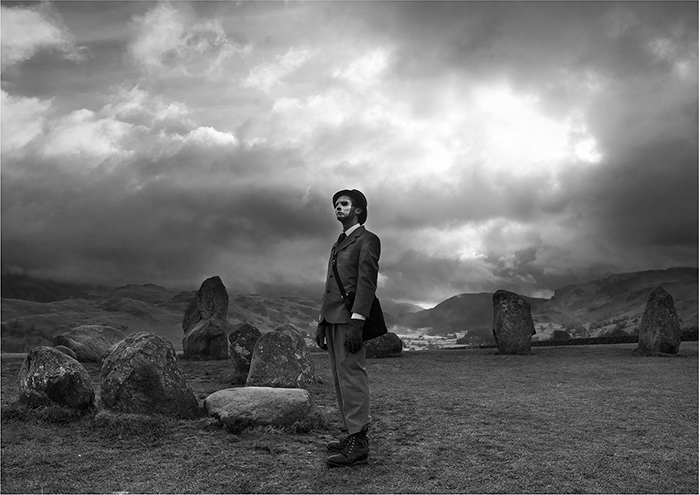
Bryan McGovern Wilson, The Alchemic Host (Castlerigg), Digital C-Print, 2012
The literal layering of history within the land there was profound. We went to St Peter’s Cathedral in Morecambe Bay that contains a Viking hogback (funerary stone) that was discovered in the graveyard. The stone explicates the story of Sigmund and Sigurd, a kind of Germanic folk tale expressed in this very kind of crude, Keith Haring-esque bas relief. It is incredibly phallic and it’s hanging out in this little chapel. Robert and I were ecstatic with this discovery, we’re in the refractory period, so to speak. And, of course, about a hundred and thirty yards away are the remains of a Celtic monastery. Up the hill, there are these burial sites that are incised into the stone itself and then, right across the way about a half mile away is Heysham Nuclear Power station. Then on the shore, right below you can find pieces of flint from Neolithic people. Flint is not native to the British Isles, it was early trade from Danish traders coming and trading. So anytime you find flint washed up on a riverbed or on the shore, it’s most likely from early Neolithic peoples.
We also encountered this elderly man, this docent named John Disney. He talked for a good half an hour about his interpretation of what the Viking hogback was and the story it depicted. He became the spirit of the project from that point on, embodying the idea that anecdotal information operates at the same level as the facts or as the material object. The genesis of meaning gets made in the intersection of all of these things.
The project became about redefining “power” and its relationship to time and culture, seeking out the oldest sites we could find. Megalithic circles became the sites we needed to go to, because they are at least five or six thousand years old, some of the oldest human sites in England. This dovetails into further conversations about nuclear waste, the strategies for marking geologic repositories, these burial sites. The half-lives of radioactive materials operate on tens of thousands of years and impossible gulfs of time.
Within my research at the time, I came across the Thomas Sebeok text, Communication Measures for Ten Millennia. He was commissioned by the US government to address particular problems associated with geologic stewardship and what strategies might be employed to mark these sites across unprecedented time frames. It is a great kind of introduction into semiotics with the nuclear waste as a framework as the core of all of it. He talks about the problems of language, symbols, and physical monuments, that all of them change too quickly to satisfy an enduring message. In the text, Sebeok proposes we could employ a select group of people in every generation to retain the information of these sites in a heavily ritualized, allegoric way and he actually calls them the atomic priests.
RC: Which connects back to the Atomic Priesthood, yes?
BMW: I got the title from the Seboek text and the latest iteration of this project will be on display at The Mildred Complex(ity) in upstate New York from June to mid July. After my initial Trinity Pilgrimage performance, there were still unresolved issues around it. There was this thing about it that that did not sit right with me. I had this desire to pay homage to Oppenheimer, this modern alchemist. But at the same time he is not me or my performance, so I wanted remove my identity from the character. I made this mask out of silver and vestments were made to replaced my thrift store suit of the Atomic Priest. I felt like the Priesthood should have a stronger, more diffused ritualistic presence within the project
RC: Okay, so what is the origin of the Great American Python ?
BMW: I had an opportunity to be an artist-in-residence in the Everglades National Park. I wanted to investigate the land through animal/human interactions. This was an element to The Cumbrian Alchemy project that I wanted to explore further. In my research about The Everglades, I came across stories of invasive Burmese pythons disrupting that environment. I had heard stories of a group of guys calling themselves the Swamp Apes who were hunting the snakes, which became a point of access for the emerging project.
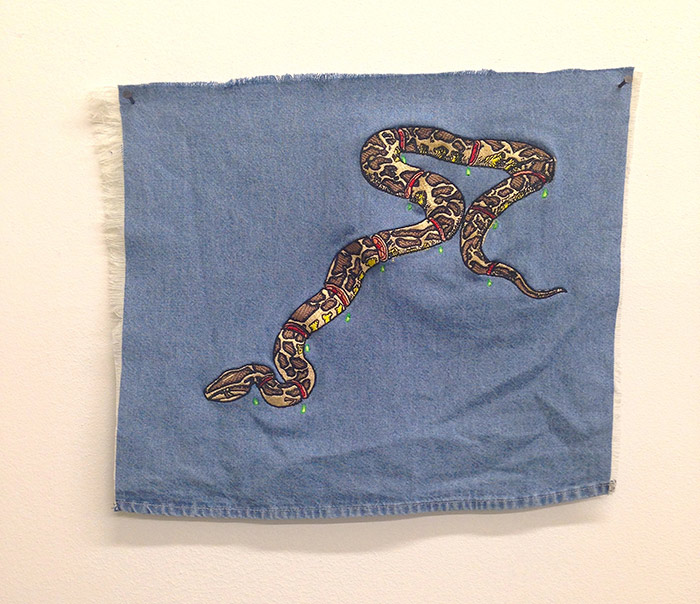
Bryan McGovern Wilson, Flag of the Land (The Great American Python), Embroidery on Denim, 14″ x 12″, 2013
I had heard stories of veterans from the Iraq and Afghanistan conflicts who were going on the these “hunts” for pythons as a way of dealing with extreme PTSD, traumatic brain injuries, general trauma, addiction. The Swamp Apes program is led by this fantastic man, Tom Rahill. Tom had no military or therapy background, just a wealth of knowledge about the South Florida landscape. He found that his engagement with the land, specifically pursuing invasive pythons was profoundly therapeutic. Tom tells the story of wrestling a large python, in the middle of the night, in tears of joy, unburdened. He thought, well it worked for me maybe it will work for these guys to deal with their traumas.
RC: Did you have any idea what you were getting yourself into in the Everglades?
BMW:I had a lot of misconceptions about going down there, especially about The Swamp Apes. It was curious timing because my residency was supposed to be an all access smorgasbord of fieldwork in the park, but then the government shutdown happened. I was informed days before I was about to leave that the park would be closed and that my residency was suspended indefinitely. I went down anyway and met with local people, wildlife biologists, artists, people who wrote guidebooks, and of course, The Swamp Apes. On the ground talking to people, you get a larger sense of what’s going on. Tom and The Swamp Apes ended up being the group I was most interested in. I loved the idea of transformation through ecological engagement. I assumed, wrongly, that this transformation was the result of this weird hunting culture that was insular, closed-off. Yet it was clearly creating this real benefit for these guys. I figured that the snake hunts were about violence or had this blood-lust component. I was so foolish. I came down there and was confronted with the complete opposite. I never met a group of people with a stronger sense of ethics.
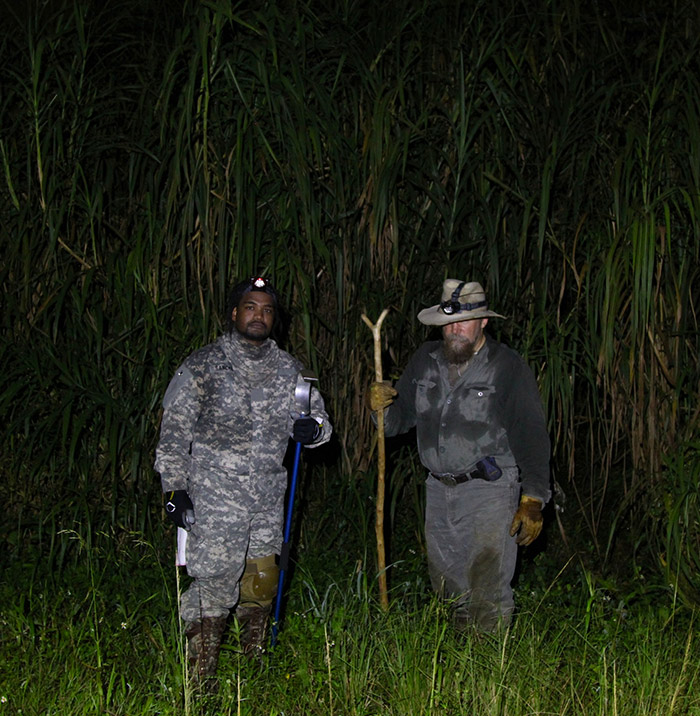
Bryan McGovern Wilson, Tom & Cesar, Digital C-Print, 2013
RC: What are the hunts like?
BMW: When they say hunts, it’s not about killing the animal although it is certainly about finding and capturing them. Killing animals in the field is really not okay. They would say “When you set out to kill the animals from the get-go, that makes you a poacher, poachers suck. We are not poachers. “
The hunts are brutal because you are going into the most inhospitable environment. There are animals that can hurt or kill you. The mosquitoes alone are brutal. There are plants there like poison ivy, but worse. You have to wear long sleeves in hot weather and walk through waist high water, sweating the whole time and you can’t see what’s below most of the time. Hunts sometimes last for four to five hours and many of the hunts begin at sundown. At night that’s when the animals come out to hunt or bask in the roads because the asphalt retains heat more than all the other spots so they like being out in the roads because it regulates their metabolism better. However, the highest concentrations of pythons are out in the deep swamp where all the prey is.
The capture is an interesting and exhausting process. Serpents have what’s referred to as capture myopathy since they are one long muscle and their respiratory system is linked to that. During periods of intense movement, they build up lactic acid quickly and when the struggle is too great, they get tired and they go limp as an autonomic response. Then it is just like handling a piece of rope. So it is a matter of wrestling the animal to the point of capture myopathy, which is usually fifteen to twenty minutes. For me fifteen to twenty minutes is a long time! Once they capture the animals, they take biometric data, GPS coordinates, bag them and send to a biologist in a lab to euthanize it. They even give the animals names.
RC: What is your projects relationship to the python?
BMW: It’s still emerging, but I came out understanding the serpent as a powerful icon and about the tenuous relationship between humans and animal. It also becomes about the transformation of identity by engaging with particular animals and the land. Also there is the problem of invasive species. There’s a multitude of invasive species in South Florida, which brings up lots of interesting questions around responsibility and long-term stewardship. Something like the Brazilian pepper is far more problematic an invasive species. However, there is something about a giant snake that generates a narrative in people’s consciousness that you can talk about, it’s exciting. So in a way, the Burmese python is an ironic godsend to those who are in wildlife education, because it makes it so easy to explain why invasive exotics are a problem. Look at this scary thing! But at the same time, this gets mirrored in a bad way with the general public and news agencies. Like “Pythons are going to eat your babies and your pets! Tune in at 9 to see the footage!”
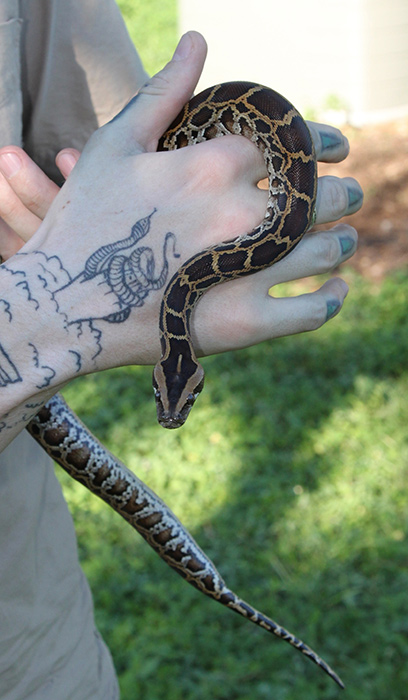
RC: What is your relationship like with the Swamp Apes?
BMW: I’ve begun to see The Everglades as an alchemic landscape. Human elements are transformed, sublimated to something different. It was the engagement with these guys that was so profound. These people who had no point of access or past relationship to ecology, stewardship, or community in the Everglades before doing these hunts who are, in turn, able to talk incredibly sensitively, eloquently about their role within the system itself and experience a self-realized transformation of identity. I think that is where the therapeutic component itself is, within identity. They now have this sense of place within the land, that their disparate skills and training that lay fallow in civilian life can be put to use in a positive way.
A lot of these dudes came from really abject lives. One member, Cesar immigrated from the Dominican Republic. He is genuinely in love with America and loved America so much that he enlisted in the army. He became one of those bomb diffusers, an IED technician, a rarified space even within the army. He got hurt during his service, his injuries forced him to come back to the States and despite his traumas, was eager to be deployed again. Injured again, coming back again and falling into addiction, almost on a whim, and deciding to give this python thing a chance. It was a complete transformation for him.
RC: Kind of goes back to the Alchemy right?
BMW: Not only does he have personal stability but now is considering what life would be like as a conservation biologist. This new identity is his relationship to animals and what’s better than that? That is the guy you want in the field.
I saw this transformation mirrored in many of the guys in The Swamp Apes. Some of them were vegetarians as a result of feeling “I don’t want animals to be hurt.” Death looms large and none of them wanted to be near it anymore. There was this anti-gun sensibility, anti-violence mindset. Some of the members brought strong Christian ideologies, which I found very curious. We were constantly having profound metaphysical conversations even though we didn’t share any ideological things in common, but nonetheless being able to have this Venn diagram of sensibilities that allowed for a profound connection. Tom and Cesar became people I really loved. Despite our political differences, a genuine respect and love was generated in exchange.
When I was asked to give a public talk at the end of the residency, I talked briefly about my work and then had Tom and Cesar talk. They totally blew everybody’s minds. Their story is profound and they have huge personalities that were able to generate new possibilities in the audience. The sharing of their collaboration was powerful. In many ways, the opportunity for them to tell their story was the most rewarding.
RC: How has your practice changed over the past four years?
BMW: So I am taking to task these obtuse, esoteric principles like deep time and alchemical transformation and seeing that they can be applied to something in the real world like The Swamp Apes, this notion of personal transformation. I hold to the possibility that an artistic practice can facilitate that for people who don’t have the direct engagement with a specific time, place, or condition. We’re so much more connected than we realize. It’s really being a facilitator, connecting the dots. Deliberately putting myself in the place of convergence is something I really seek out.
Bryan’s exhibition The Atomic Priesthood is on display at Mildred’s Complex(ity) Project Space, Narrowsburg, NY
For more information about Bryan and his projects, please visit his website.
* All Images Courtesy of the Artist
